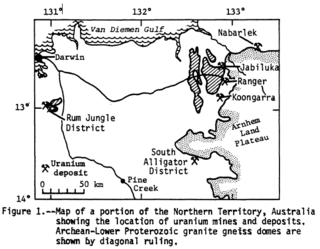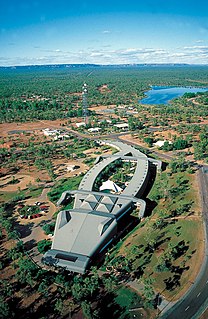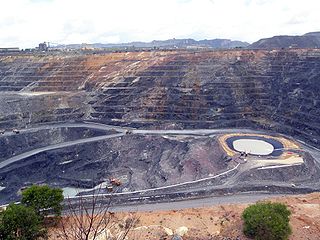
This is a List of Australian inquiries and reports relating to uranium mining issues. [4]

This is a List of Australian inquiries and reports relating to uranium mining issues. [4]
For several decades uranium mining has been a major part of the Australian political landscape, with opposition groups citing the wide-ranging environmental impacts, indigenous land access and nuclear proliferation as reasons for ceasing or restricting the industry. The debate has resulted in limitations on mining and export activities, with Federal and State governments occasionally flip-flopping on public policy. In the meantime, mining companies have pursued exploration activities, and in some instances stockpiled mined ore.

Jabiluka is a pair of uranium deposits and mine development in the Northern Territory of Australia that was to have been built on land belonging to the Mirarr clan of Aboriginal people. The mine site is surrounded by, but not part of, the World Heritage–listed Kakadu National Park.

The Ranger Uranium Mine was a uranium mine in the Northern Territory of Australia. The site is surrounded by, but separate from Kakadu National Park, 230 km east of Darwin. The orebody was discovered in late 1969, and the mine commenced operation in 1980, reaching full production of uranium oxide in 1981 and ceased stockpile processing on 8 January 2021. Mining activities had ceased in 2012. It is owned and operated by Energy Resources of Australia (ERA), a public company 86.33% owned by Rio Tinto Group, the remainder held by the public. Uranium mined at Ranger was sold for use in nuclear power stations in Japan, South Korea, China, UK, France, Germany, Spain, Sweden and the United States.

The Australian Conservation Foundation (ACF) is Australia's national environmental organisation. ACF is a community of over 700,000 people who speak out, show up and act for a world where forests, rivers, people and wildlife thrive. Founded in 1965, ACF has been a powerful voice for the environment for more than 50 years. It is an independent, non-partisan, non-profit organisation focused on advocacy, policy, research and community organising.

Rum Jungle is a locality in the Northern Territory of Australia located about 105 kilometres south of Darwin on the East Branch of the Finniss River. It is the site of a uranium deposit, found in 1949, which has been mined.

Alligator Rivers is the name of an area in an Arnhem Land region of the Northern Territory of Australia, containing three rivers, the East, West, and South Alligator Rivers. It is regarded as one of the richest biological regions in Australia, with part of the region in the Kakadu National Park. It is an Important Bird Area (IBA), lying to the east of the Adelaide and Mary River Floodplains IBA. It also contains mineral deposits, especially uranium, and the Ranger Uranium Mine is located there. The area is also rich in Australian Aboriginal art, with 1500 sites. The Kakadu National Park is one of the few World Heritage sites on the list because of both its natural and human heritage values. They were explored by Lieutenant Phillip Parker King in 1820, who named them in the mistaken belief that the crocodiles in the estuaries were alligators.

Jabiru is a town in the Northern Territory of Australia. Built in 1982, the town is completely surrounded by Kakadu National Park. At the 2016 census, Jabiru had a population of 1,081. It is named after the black-necked stork often seen in the wetlands and billabongs of Kakadu, which is commonly referred to in Australia as a Jabiru.

Uranium mining is the process of extraction of uranium ore from the ground. The worldwide production of uranium in 2019 amounted to 53,656 tonnes. Kazakhstan, Canada, and Australia were the top three uranium producers, respectively, and together account for 68% of world production. Other countries producing more than 1,000 tonnes per year included Namibia, Niger, Russia, Uzbekistan, the United States, and China. Nearly all of the world's mined uranium is used to power nuclear power plants. Historically uranium was also used in applications such as uranium glass or ferrouranium but those applications have declined due to the radioactivity of uranium and are nowadays mostly supplied with a plentiful cheap supply of depleted uranium which is also used in uranium ammunition. In addition to being cheaper, depleted uranium is also less radioactive due to a lower content of short-lived 234
U and 235
U than natural uranium.

Energy Resources of Australia Ltd is a public company based in Australia. It is a subsidiary of the Rio Tinto Group which owns 68.4% of the company. The remainder is publicly held and traded on the Australian Securities Exchange. The chairman is Peter McMahon and Chief Executive is Andrea Sutton.

Kakadu National Park, located in the Northern Territory of Australia, possesses within its boundaries a number of large uranium deposits. The uranium is legally owned by the Australian Government, and is sold internationally, having a large effect on the Australian economy. The mining has been controversial, due to the widespread publicity regarding the potential danger of nuclear power and uranium mining, as well as because of objections by some indigenous groups. This controversy is significant because it involves a number of important political issues in Australia: Native Title, the environment, and Federal-State-Territory relations.

Nuclear weapons testing, uranium mining and export, and nuclear power have often been the subject of public debate in Australia, and the anti-nuclear movement in Australia has a long history. Its origins date back to the 1972–73 debate over French nuclear testing in the Pacific and the 1976–77 debate about uranium mining in Australia.
Russell Walter Fox AC QC LLB was an Australian author, educator, jurist and former chief judge of the Supreme Court of the Australian Capital Territory. He is best known for his extensive report on uranium mining in Australia in the early 1980s.
Yvonne Margarula is an Aboriginal Australian environmentalist who won the 1998 Friends of the Earth International Environment Award and the 1998 Nuclear-Free Future Award. She also won the 1999 US Goldman Environmental Prize, with Jacqui Katona, in recognition of efforts to protect their country and culture against uranium mining.
Jacqui Katona is a western-educated Aboriginal Australian woman who led the campaign to stop the Jabiluka uranium mine in the Northern Territory. In 1998 the Mirrar Aboriginal people, together with environmental groups, used peaceful on-site civil disobedience to create one of the largest blockades in Australia's history. Katona won the 1999 U.S. Goldman Environmental Prize, with Yvonne Margarula, in recognition of efforts to protect their country and culture against uranium mining.

The prospect of nuclear power in Australia has been a topic of public debate since the 1950s. Australia has never had a nuclear power station. Australia hosts 33% of the world's uranium deposits and is the world's third largest producer of uranium after Kazakhstan and Canada.

Radioactive ores were first extracted in South Australia at Radium Hill in 1906 and Mount Painter in 1911. 2,000 tons of ore were treated to recover radium for medical use. Several hundred kilograms of uranium were also produced for use in ceramic glazes.

Radium Hill is a former minesite in South Australia which operated from 1906 until 1961. It was Australia's first uranium mine, years before the country's next major mines at Rum Jungle in the Northern Territory (opened in 1950), and the Mary Kathleen mine in Queensland (1958). The associated settlement which once housed up to 1,100 people is now a ghost town, largely abandoned and demolished. The former townsite and cemetery were provisionally listed on the South Australian Heritage Register on 24 August 2016. During its main period of production between 1954 and 1961 the mine produced nearly 1 million tonnes of davidite-bearing ore to produce about 860 tons of U3O8.

The uranium mining debate covers the political and environmental controversies of the mining of uranium for use in either nuclear power or nuclear weapons.
The world's largest producer of uranium is Kazakhstan, which in 2019 produced 43% of the world's mining output. Canada was the next largest producer with a 13% share, followed by Australia with 12%. Uranium has been mined in every continent except Antarctica.
Ranger Uranium Environmental Inquiry (RUEI) was a committee established by the Whitlam Government in Australia, which sought to explore the environmental concerns surrounding uranium mining.

David Noonan is an Australian environmentalist and member of the anti-nuclear movement in Australia. Noonan is a former anti-nuclear campaigner for the Australian Conservation Foundation, and has been a prominent spokesperson during campaigns against the expansion of uranium mining in Australia and against the establishment of nuclear waste storage facilities. He has a science degree and a Masters in Environmental Studies.
{{citation}}: CS1 maint: multiple names: authors list (link){{cite web}}: CS1 maint: archived copy as title (link) Australia’s uranium